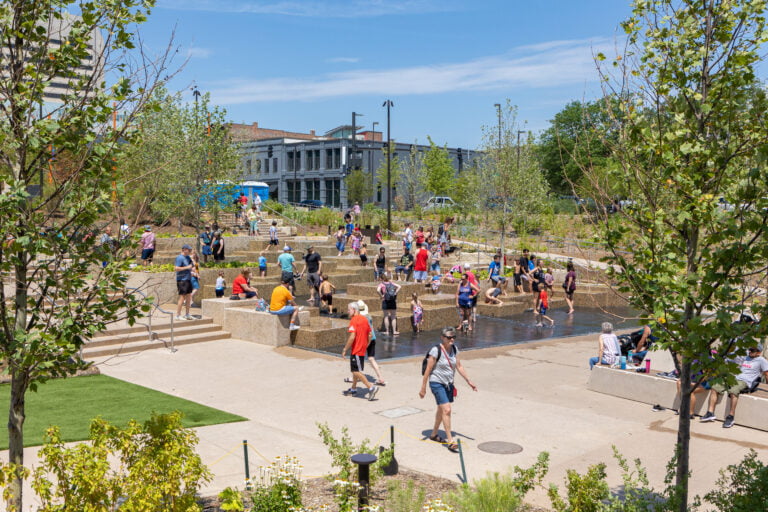As downtown plans for a new park, let’s look at six ways Omaha’s public spaces play a crucial role in creating healthy, vibrant communities where people can connect, engage, and thrive.
What benefits do public spaces in Omaha provide?
1. Encouraging social interaction. Parks and community centers provide grounds for social interaction, which helps to build relationships among neighbors and strengthens a sense of community. Many local parks offer free covered shelters and barbecue grills for parties and other outdoor gatherings. Community center amenities such as tabletop games, communal seating areas, and group hobby classes help residents create meaningful interactions and social bonds.
2. Promoting physical activity. Playgrounds, sports fields, and walking trails provide opportunities for physical activity and exercise, which promote healthy lifestyles for residents. Easy access to spaces with exercise equipment creates cost-effective alternatives or supplements to conventional gym memberships. In addition to low-cost gym access at a city community center, Omaha residents can enjoy free fitness activities such as the fitness equipment area in Elmwood Park or free outdoor fitness classes at the Highlander Accelerator or Turner Park at Midtown Crossing.
3. Enhancing mental health and well-being. Green spaces and community gardens create a sense of tranquility and connection to nature, which can reduce stress and anxiety. Omaha has many recreational areas with ample green space, such as the OPPD Arboretum and Neale Woods. With a fishing license, residents can cast a line and relax at one of the many artificial lakes around town, such as Lake Zorinsky or the Benson Park Lagoon.
4. Fostering civic engagement. Public spaces like town halls provide a venue for civic engagement, such as community meetings and public forums, which encourage resident participation and democratic decision-making. Many local churches and libraries offer free space for community groups to assemble for discussion of current issues or to meet with local officials. The Omaha-Douglas Civic Center hosts Omaha City Council meetings, where residents can give testimony for or against ordinances that affect their communities.
5. Boosting local economies. Shopping districts and farmers’ markets attract people to the area and support local businesses, boosting the local economy. Various local markets across the city allow farmers, gardeners, butchers, bakers, makers, and more opportunities to show and sell their wares. The city has also developed many popular walkable shopping and entertainment districts in the hearts of local neighborhoods, such as Aksarben Village, Midtown Crossing, Blackstone, and Benson.
6. Promoting cultural exchange. Festivals, museums, and cultural events create opportunities for cultural exchange and celebration of diversity, which can promote understanding and respect. Omaha hosts many cultural events, including the Omaha Freedom Festival, La Festa Italiana, and Oktoberfest. Museums, including El Museo Latino, the Great Plains Black History Museum, and the Durham Western Heritage Museum, offer explorations of the area’s rich cultural histories. BFF, the Summer Arts Festival, KANEKO, and the Bemis Center for Contemporary Arts create free opportunities for interaction and discussion around visual arts in Omaha. Public art is also popular and easy to find throughout the city.
How do neighborhoods interact with public spaces?
The characteristics of a neighborhood, such as the level of diversity, safety, accessibility, and quality of amenities and services available, can influence how public spaces are used and perceived by the community.
For example, a neighborhood with high engagement and inclusiveness may foster a sense of community and encourage people from different backgrounds to come together and use public spaces. On the other hand, a neighborhood with safety concerns and low engagement may discourage people from using public spaces, causing disinvestment and limiting the potential for social interaction and community building.
Additionally, the quality of public spaces, such as parks and sidewalks, can profoundly impact the neighborhood’s overall quality of life. Well-maintained public spaces can attract people to spend time outdoors, engage in physical activity, and interact with their neighbors. At the same time, poorly maintained areas may be seen as unsafe, unattractive, and unusable.
We’ve already shared how the North Omaha Trail is enhancing connectivity, walkability, and opportunities for recreation while promoting the rich history and culture of the Black community in North Omaha neighborhoods. We’ve also covered how the Walnut Hill Commons community center facilitates relationship building, education and employment, leadership development, and neighborhood development efforts.
By investing in a neighborhood’s physical and social infrastructure, communities can create more vibrant, inclusive, and livable public spaces that benefit everyone.
This blog was written by Noelle Blood-Anderson, One Omaha’s communications manager.

